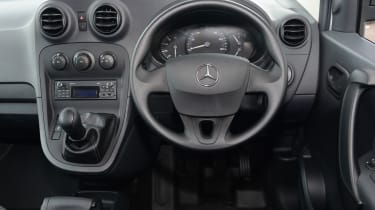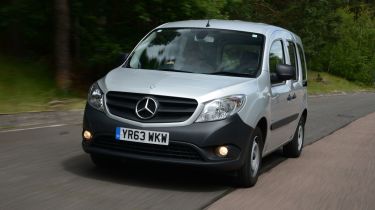Mercedes Citan Traveliner review
The Mercedes Citan is a Renault Kangoo-based MPV, aimed squarely at the likes of the VW Caddy Maxi Life

The Mercedes Citan Traveliner is a small people carrier that replaces the compact Vaneo in the manufacturer’s line-up. But while that car was based on the old A-Class supermini, the Citan is van-based, and is a product of a joint venture between Mercedes and Renault.
It comes available with two diesel engine options shared with Renault. They have been rebadged from Renault's dCi to become the usual CDI associated with Mercedes and are availabel with either 89bhp or 109bhp.
The Citan van is also sold in the UK as the Renault Kangoo, although the French company doesn’t sell a dedicated people carrier version like the Traveliner.
Engines, performance and drive
The looks can’t hide the Citan’s van roots, and neither can the driving experience. There's an 89bhp 1.5-litre diesel from Renault with Merc’s CDI badging and, while it delivers decent efficiency, it’s not a great performer.
A slower 0-60mph time of 12.8 seconds and power disadvantage compared to direct rivals means the Citan isn't a perky performer. A torque figure of 200Nm is 85Nm down on a comparable Tourneo means the Mercedes is likely to struggle with a full load of passengers and luggage.

The 1.5 CDI sounds pretty rough, too. If you want more power, then the 111 CDI model has 109bhp, and prices start from £21,102.
Used - available now

2024 Cupra
Formentor
38,254 milesAutomaticPetrol2.0L
Cash £24,000
2023 SEAT
Ateca
45,002 milesManualDiesel2.0L
Cash £18,000
2023 Hyundai
Tucson
41,311 milesAutomaticPetrol1.6L
Cash £17,500
2020 Suzuki
Vitara
19,621 milesManualPetrol1.4L
Cash £16,450The five-speed gearbox has a notchy shift, but the steering is reasonably light and turn-in is sharp, plus there’s plenty of grip in corners. As you’d expect, there’s a fair amount of body roll, but it feels well controlled, although the Citan isn’t exactly fun to drive. Take it easy, and the buzz of the diesel engine spoils refinement, as the suspension does a decent job of soaking up bumps.
MPG, CO2 and Running Costs
The Citan Traveliner is a relatively expensive offering compared with rivals. A mid-spec model comes in at around £2,000 more than a top-spec Ford Tourneo Connect. That would be fine if they were similarly equipped, but the Citan is pretty basic when compared to the Ford.
You can add parking sensors and alloy wheels, but kit such as panoramic glass, sat-nav, DAB radio, heated seats and climate control aren’t available. Mercedes does offer option packs to upgrade the Citan, including the Appearance Pack (£686) and Drivers Pack (£1,222), which adds folding mirrors, parking sensors and extra storage.
What the Citan lacks in performance, it makes up for with economy. The 60-litre fuel tank means you can travel more than 600 miles between fills.
Claimed emissions of 119g/km means road tax costs just £30 per year. Servicing is pricey, although four-year breakdown cover and variable service intervals are plus points.
Interior, design and technology
Van-based people carriers aren’t the prettiest cars on the road, and the Mercedes Citan Traveliner does nothing to hide its commercial vehicle roots. Its origins as a Renault are pretty clear, too, as the car’s silhouette is identical to the Kangoo, with an upright rear end, and slab sides with unsightly black door runners cut into them.
Mercedes has added its distinctive corporate grille so the Citan has a family resemblance to the larger Vito and Sprinter vans, but the plastic bumpers, steel wheels and black door handles and wing mirrors are a far cry from the upmarket look and feel of Merc’s car range. There is a £686 Appearance Pack available, which colour matches the bumpers, mirrors and tailgate trim, and also adds 15-inch alloy wheels.
Pull any of the flimsy plastic door handles, and they feel like they might just break off in your hand before you’ve opened the door. There’s none of the solidity you’d expect from a Mercedes, and this is doubly disappointing when you have to give the sliding rear doors a fair old yank to get them open.
The cabin has a far more van-like feel than rivals such as the Ford Tourneo Connect and VW Caddy Maxi Life. Everything from the dash to the steering wheel and gearlever is covered in cheap grey plastic, while the rubber floor covering only adds to the Citan’s functional appearance. The black and grey seat trim is also functional rather than plush.
Add in switchgear, a stereo and instrument binnacle that are all clearly from the Renault parts bin, and the Citan couldn’t be further removed from the Mercedes model range in terms of appearance or quality. At least you won’t mind getting the cabin dirty, as it will be a piece of cake to clean.
Practicality, comfort and boot space
The Citan Traveliner has a vast interior. The sliding doors need a bit of welly to get them to open or close, and the exterior door handles feel flimsy to use, but there’s no problem with head or legroom once you’re in.
The raised roofline makes space for a large shelf above the front seats, which is ideal for storing paperwork or an umbrella, but the Merc’s French roots are exposed by the fact that the glovebox is tiny, thanks to the position of the fuses behind it – as a result, it’s too small to even store the owner’s manual in.

The boot is square, and the level boot lip makes loading heavy items easy, while the rubber boot floor means moving items is a breeze, although that does mean they slide about when the car is cornering.
Plus, the rear seats fold into the footwells in a single action, unlike its rivals, which need their seats removed to achieve their maximum capacity.
Reliability and Safety
Mercedes has a strong reputation for reliability, and must have strong faith in Renault’s ability to deliver reliable running gear to even consider joining forces with it to produce the Citan. However, the Kangoo has been in production since 2008, so any potential problems should have been ironed out long ago.
The Citan is built at the same factory as the Kangoo in northern France, while the engines and gearboxes are used in models throughout the Renault and Nissan ranges, so they’re tried and tested, and should be relatively trouble-free.
Euro NCAP has actually tested the Citan twice for safety. It was given a three-star rating early in 2013, but Mercedes made some immediate changes, and in the retest it earned a four-star rating. It features stability control, six airbags and Isofix child seat attachments, although the latter look rather untidy, as they’re stuffed away in the foam padding of the back seats.
